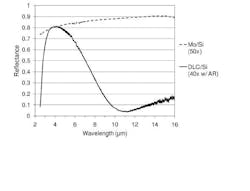UV OPTICS: EUV mirror shows near-zero reflectance at CO2 laser wavelength
In a collaborative effort between researchers at Philips Research Laboratories (Eindhoven, The Netherlands), the Fraunhofer Institute for Material and Beam Technology (IWS; Dresden, Germany), Lambda Research Optics Europe (Eke, Belgium), and ASML (Veldhoven, The Netherlands), an extreme-ultraviolet (EUV) multilayer mirror has been developed with near-zero IR reflectance at the critical CO2 laser wavelength of 10.6 µm—the wavelength used to produce an EUV-emitting plasma that serves as the light source for EUV lithography applications. The new mirror can significantly diminish the amount of IR light that propagates into the lithography tool; less transmitted IR light results in less heating of the optics and increased exposure resolution.
Diamonds: A mirror's best friend
Recognizing that IR reflectance from conventional molybdenum/silicon (Mo/Si) mirrors is caused by metallic molybdenum in the multilayer stack, the research team replaced molybdenum with a diamond-like carbon (DLC) material that is reflective to EUV but transparent to IR wavelengths. The idea came from carbon/carbon (C/C) multilayer mirrors that are used for x-ray optics. While these C/C mirrors have limited use for EUV applications due to their high absorption at the target 13.5 nm EUV wavelength, a DLC-based mirror has many of the same characteristics, with substantial transparency to IR radiation.
The new multilayer coating was created as one component of an antireflection (AR) coating for 10.6 µm wavelengths. Starting with a 10.6 µm transparent silicon substrate, AR coatings are needed on the front and back side of the substrate. The AR coating on the front side includes the IR-transparent DLC/Si multilayer coating (which has a refractive index of about 3 at 10.6 µm), a low-index (1.32) thorium fluoride (ThF4) coating, and an auxiliary Si coating. The coating on the back side is a zinc selenide ThF4 (ZnSe/ThF4) bilayer AR coating.
Fabrication challenges
Although straightforward to specify, practical fabrication of the mirror presented two main challenges: how to fabricate a ThF4 coating with a required IR AR coating roughness value below 0.5 nm root-mean-squared (rms), and overall fabrication of the new EUV-reflective DLC/Si coating, which had never before been fabricated.
To achieve a super-smooth finish for the ThF4 coating, an iterative process of Si smoothing layers and ion-beam polishing was used. After four iterations, roughness was reduced to 0.24 nm rms. And, to fabricate the DLC/Si coating, various process parameters such as coating thickness and periodicity of the layers were tested in order to determine the optimum formula for the first prototype: a 40 period multilayer design with 2.8 nm thick DLC and 4.1 nm thick Si alternating layers, deposited using argon ions at 1200 eV.
Essentially, the number of periods in the multilayer is a tradeoff between EUV reflectance and IR suppression. The final mirror used in testing began with a 40 period multilayer, a 20 nm thick Si smoothing layer, and a 700 nm thick ThF4 layer (top AR coating) followed by the silicon substrate and a 684 nm thick ThF4 layer bonded to a 460 nm thick ZnSe layer (bottom AR coating).
Comparison of the DLC/Si mirror with a standard Mo/Si mirror using both a laser-produced-plasma (LPP)-based EUV reflectometer and a Fourier transform IR (FTIR) spectrometer revealed IR reflectance (and EUV reflectance) values at 10.6 µm of 4.4% and 88.5% (and 42.5% and 69.4%), respectively (see figure). Using the DLC/Si mirror as a spectral-purity filter in the collection or illumination optics of an EUV lithography source would increase the spectral purity of the EUV radiation with respect to IR by a factor of 12 at a relative efficiency of 61%.
REFERENCE
- W.A. Soer et al., Optics Lett. 34(23), p. 3680 (Dec. 1, 2009).

Gail Overton | Senior Editor (2004-2020)
Gail has more than 30 years of engineering, marketing, product management, and editorial experience in the photonics and optical communications industry. Before joining the staff at Laser Focus World in 2004, she held many product management and product marketing roles in the fiber-optics industry, most notably at Hughes (El Segundo, CA), GTE Labs (Waltham, MA), Corning (Corning, NY), Photon Kinetics (Beaverton, OR), and Newport Corporation (Irvine, CA). During her marketing career, Gail published articles in WDM Solutions and Sensors magazine and traveled internationally to conduct product and sales training. Gail received her BS degree in physics, with an emphasis in optics, from San Diego State University in San Diego, CA in May 1986.
